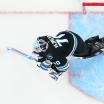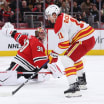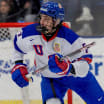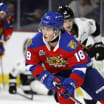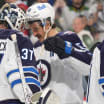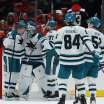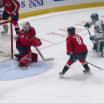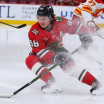Almost 80 years later, Fred Sasakamoose remembers vividly how his grandfather, Alexander, taught him to skate on the reservation at Sandy Lake, Saskatchewan (now Ahtahkakoop Cree Nation).
Fred, then 5, was wearing five pairs of socks and moose-hide moccasins strapped into double-runner bob skates. Alexander would load him into a toboggan and pull him down the hill from his log house to the frozen lake. Using a hockey stick his grandfather whittled out of willows and a puck of frozen horse manure, Fred played while Alexander, a deaf mute, would sit on a bucket and ice fish.
Sasakamoose trailblazer on ice
First Indigenous player in NHL recalls improbable, inspirational journey

"When I'd fall down, he'd get up with a smile and pick me up and put me back on my feet," Fred said. "He was a good old man. I understood him even though he couldn't talk."
So began Sasakamoose's remarkable journey to becoming the NHL's first Indigenous player. It was a long, difficult road that included years of enduring Canada's residential school system - boarding schools that attempted to assimilate the country's aboriginal children. But Sasakamoose never abandoned his language, cultural beliefs and way of life. And on Feb. 27, 1954, he made his NHL debut with the Chicago Black Hawks against the Toronto Maple Leafs at Maple Leaf Gardens.
\[RELATED: Complete Hockey Is For Everyone coverage\]
"Grandpa must have had a vision," Sasakamoose said.
Sasakamoose's 11 games with the Black Hawks at the end of the 1953-54 season were the extent of his NHL career. Yet he's spent much of the past 50 years working with Indigenous youth and encouraging their participation in sports, including hockey.
Sasakamoose, who is serving a special ambassador during Hockey Is For Everyone month, will be back in Toronto at Air Canada Centre on March 10 with a group of about 25 youth players from the 2018 Little Native Hockey League, a tournament featuring 3,300 status-Indian players to be held March 11-15 in Mississauga, Ontario. They'll attend the Maple Leafs morning skate and possibly their game against the Pittsburgh Penguins.
"With Fred, it seems like in the last few years he's only began to make his mark," said Little NHL tournament coordinator Brendan Biederman, who is from Moose Cree First Nation. "I followed hockey growing up like any other Canadian kid would and I really never heard of Fred Sasakamoose until the last four or five years. Within the last year, his story has gained some traction in the country and has really taken off."
\\*
On Dec. 29, Sasakamoose was named as one of 125 new appointments to the Order of Canada, which recognizes Canadian citizens who have made outstanding contributions to their community or the country. Sasakamoose was stunned when he received the phone call from the Governor General's Office in Ottawa to inform him.
"It's the highest honor anybody could achieve, an award like that," Sasakamoose said. "It's something that's impossible to an Indian like me, an Indian boy that was raised in a residential school and through a hard life on the reservation."
Sasakamoose was 6 in September 1940 when he and his older brother, Frank, were taken off the reservation, and away from their parents to be sent to St. Michael's Indian Residential School in Duck Lake, Saskatchewan. The nine years Sasakamoose spent there were lonely, but made him cherish his heritage even greater.
"The residential school was a place so that Indian kids could go to school, but we lost our culture," Sasakamoose said. "We were forbidden to speak (their language). … The priests and the sisters, although some of them were kind, some of them were harsh."
One of those who helped Sasakamoose was Father Georges Roussel, who arrived in 1944 as the school's new athletic director and hockey coach. Sasakamoose remembers skating up to four hours a day under Roussel, but the work paid off with a Saskatchewan midget championship in 1949.
"He was tough on me. I don't know if you would say mean. He was a dedicated man," Sasakamoose said of Roussel. "He always said, 'Freddie, I'm going to make a champion out of you.' And he did."
Sasakamoose was 15 when he returned to his reservation and had no interest in leaving again when Roussel showed up one day with George Vogan, the general manager of the Moose Jaw Canucks of the Western Canada Junior Hockey League. While he was at the residential school, Roussel would turn on the radio every Saturday so the students could listen to Foster Hewitt on Hockey Night in Canada, but Sasakamoose never dreamed then that he'd play in the NHL.
Over his four seasons with Moose Jaw, he realized he was as good as any player in the WCJHL. In 1953-54, he had 57 points (31 goals, 26 assists) in 34 games and was named the league's most valuable player.
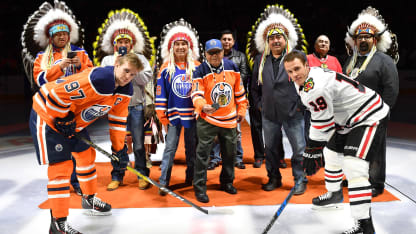
© Andy Devlin/Getty Images
Following Moose Jaw's final game of the 1953-54 season in Regina, Vogan entered the locker room, opened a telegram and read it aloud: "Fred Sasakamoose report immediately to the Chicago Black Hawks."
"We never thought we would make it to the NHL," Sasakamoose said. "We thought about wanting to play, but the dream was impossible until this white man [Vogan] picked me up from Moose Jaw."
After a two-day train trip from Regina to Toronto, Sasakamoose arrived at Maple Leaf Gardens. He remembers famed broadcaster Foster Hewitt asking during pre-game warmups how to pronounce his name, and walking into the locker room, seeing Black Hawks legends such as Bill Gadsby and Bill Mosienko, and his No. 21 jersey hanging beside theirs.
"Those are the greatest moments in your life," Sasakamoose said. "George always said, 'This ceiling, the lights. You think that's impossible to touch? Nothing is impossible. If you want to be determined, you'll be able to touch that ceiling regardless of how high it is.' He said, 'You will touch it. You mark my words.'
"When I went to that Maple Leaf Gardens and I looked up three balconies, I looked a little further up at the lights and the ceiling. Wow, this was what George was talking about. White men, sometimes you don't understand what he means and words that he uses, and I understood, just like my grandpa."
\\*
Sasakamoose did not make the Black Hawks roster in 1954-55 and split that season between the Chicoutimi Sagueneens of the Quebec Hockey League and the New Westminster Royals in the Western Hockey League.
In 1955-56, he played two games for the Calgary Stampeders in the WHL before he decided he had enough. He had married his wife, Loretta, in July 1955 and simply wanted to go home.
During his tryout in Moose Jaw, Sasakamoose became homesick and walked more than 25 miles toward Sandy Lake before Vogan tracked him down and convinced him to come back. This time, he took a taxi more than 600 miles from Calgary to Sandy Lake to be with Loretta, and that was essentially the end of his pro career.
"I always wanted to go home," he said. "I wanted to go home with my own people because home, my reservation, where I'm sitting right now, is home forever."
After the Black Hawks granted him amateur status, Sasakamoose played for the Kamloops Chiefs in the Okanagan Senior Amateur Hockey League from 1956-57 to 1959-60. During that time, he was made an honorary chief of the Kamloops Indian Reserve and was given the name "Chief Thunder Stick" because of his booming slap shot. When he was playing in Moose Jaw, he was given the title, "Chief Running Deer."
Sasakamoose finished up his playing career with a three-game stint with the Saskatoon Quakers in the Western Canada Senior Hockey League in 1965-66. His focus since has been on trying to help others like Vogan once helped him.
"My mom was an Indian. My dad was an Indian. I look around me and I see them talking to me," Sasakamoose said. "I have pictures on my wall. These are just the reminders of my life and what I have done and I have to carry on and give it back, give it back to the younger generation, younger people.
"Give back what I had, what a white man has given me. Give it back."
